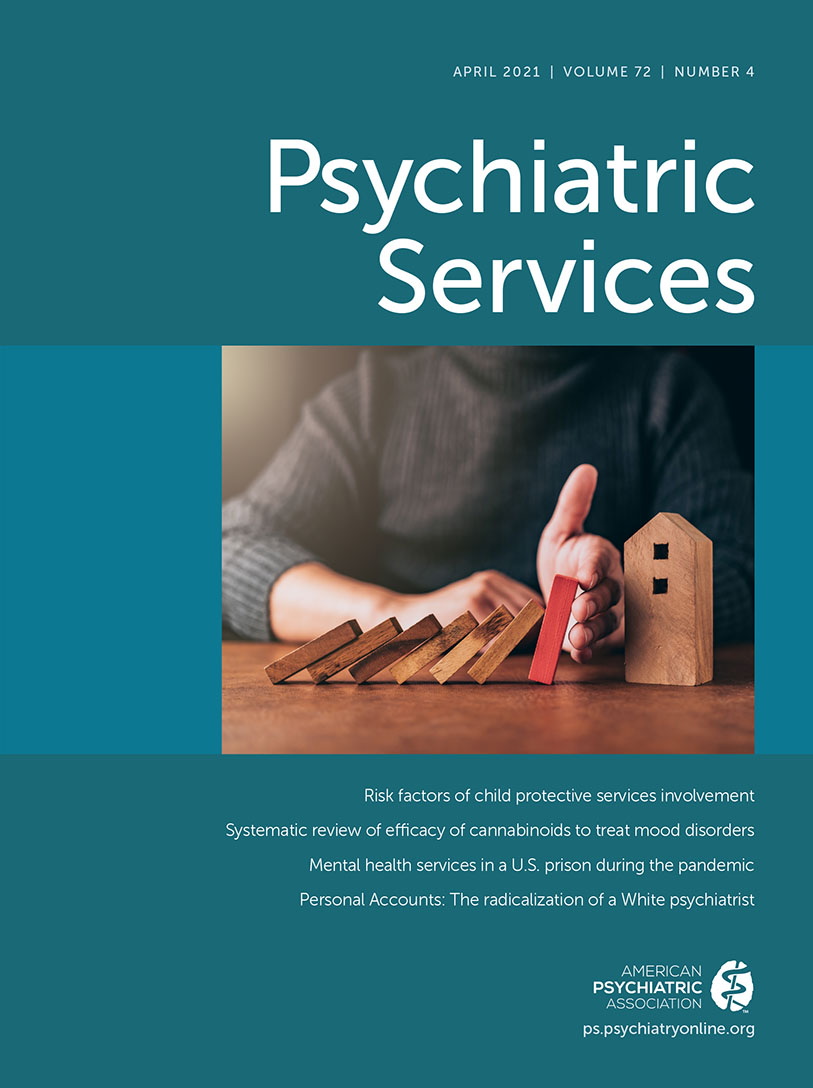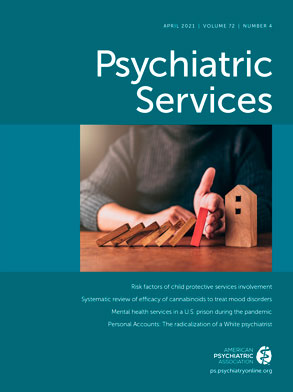Sudden death is an event that leaves many families overwhelmed and burdened by the abrupt loss of their loved ones. In the United States, the estimated incidence of sudden death is 35.1 per 100,000 persons or approximately 10% of all deaths among working-age adults (
1). Review of medical and death records of sudden-death victims may improve our understanding of sudden-death risk factors and guide interventions to help prevent these premature deaths.
Mental illness and substance-related disorders are highly prevalent worldwide and are associated with reduced life expectancy (
2). In the United States, the life expectancy of people with serious mental illness is approximately 30%, or 25 years, shorter than that of people in the general population (
3). Approximately 50%–90% of people with serious mental illness have at least one chronic medical illness (
4), often with an earlier age at onset of medical illness compared with the general population (
5). Cardiovascular disease likely contributes to the reduction in life expectancy for those with mental disorders (
6). Indeed, young adults with serious mental illness carry a threefold elevated mortality risk associated with coronary heart disease (
7). The risk for developing cardiovascular disease, arrhythmia, and cardiac arrest is particularly elevated among those with depression (
8,
9), anxiety disorders (
10), substance-related disorders (
11,
12), bipolar disorder, and schizophrenia (
13,
14). Limited information is available on mental illness, substance use, and treatment received prior to death of sudden-death victims. By characterizing this population, we might better understand the role of psychiatric care in sudden death prevention.
The Sudden Unexpected Death in North Carolina (SUDDEN) registry of out-of-hospital deaths in Wake County, North Carolina, provides a unique resource to estimate the prevalence of mental illness, substance use disorders, and mental illness treatments among victims of sudden death (
15). Our aims were to estimate the prevalence of depressive, anxiety, bipolar, psychotic, and substance use disorders as well as treatment history in a population-based sample of sudden-death victims and to compare the characteristics of victims with mental illness with those without mental illness.
Results
Demographic and lifestyle variables for the sudden-death victims with medical records (N=270) are presented in
Table 1. Most victims were male, unmarried, and White and had low educational attainment. Their mean±SD age was 53.6±8.8 years. Chronic comorbid conditions, including hypertension (N=194, 72%), diabetes (N=93, 34%), coronary disease (N=77, 29%), and respiratory disease (N=108, 40%), were prevalent among the victims, both among those with and without mental disorders.
More than one-half (59%) of the sudden-death victims had at least one documented mental disorder or substance-related disorder in their medical record (
Table 2). Among substance use disorders, alcohol-related disorders were especially common, including alcohol abuse (N=37), alcohol dependence (N=18), alcohol use disorder (N=4), and alcohol withdrawal (N=9). Cannabis-related disorders (N=13), opioid-related disorders (N=14), and stimulant-related disorders (N=16) were also present among victims.
Overall, 39% (N=106) of the sudden-death victims had more than one mental disorder or substance use disorder diagnosis. Fewer than one-half (41%) of victims with a mental disorder or substance use disorder diagnosis had a documented referral to a mental health professional, and about one-third (33%) had a documented visit with a mental health provider (
Table 2).
Almost one-half (46%) of the sudden-death victims had received prescriptions for psychotropic medications (
Table 3). Psychotropic prescriptions were more common among victims with mental disorder diagnoses (76%–78%) than among those without mental disorder diagnoses (19%). In cases with a diagnosis of bipolar disorder or schizophrenia, antipsychotics were the most commonly recorded psychotropic medication class (46%). Among those with depressive or anxiety disorders, antidepressants (51%) were most common. Second-generation antidepressants and second-generation antipsychotics were used more frequently than older antidepressants and first-generation antipsychotics. Among victims with a substance-related disorder, 60% had a prescription for a psychotropic medication. Use of opioids and gabapentin were reported more often among victims with a mental disorder diagnosis than among those without a diagnosis of mental disorder or substance use disorder.
Discussion
The findings of our study highlight the association between mental disorders and sudden death. More than one-half of the sudden-death victims in the present study had at least one mental disorder or substance use disorder documented in their medical records within 5 years of their death, and more than one-third of the victims had more than one mental or substance use disorder. Among those with mental and substance use disorders, cardiovascular, respiratory, and metabolic conditions were common. Our findings extend the results of previous research on the relationships of depression with sudden cardiac death among women (
8) and of schizophrenia with sudden death (
14). Our results also expand on the diversity of mental health and substance use disorders in working-age adults with sudden death.
Our study was conducted in a generally healthy population. Wake County has a heterogeneous population and is ranked as one of the healthiest counties in the United States. The prevalence of mental illness and substance use disorder in this county is low. In the 2014 Behavioral Risk Factor Surveillance System survey for Wake County, only 5.9% of the population reported heavy drinking, and 17.2% were “ever told” that they had a depressive disorder (
19). During this period, Wake County was ranked first among the 100 counties in North Carolina for health outcomes and healthy behaviors and had a very low drug overdose rate (
20). Our findings are important and unique because we identified the prevalence of chronic mental disorders among all sudden-death victims in a diverse, healthy population of an entire U.S. county. We included only medically reported diagnoses, an approach that may have caused underestimation of the prevalence of mental illness and substance use disorder among sudden-death victims because some mental and substance use disorders may have been unreported or undiagnosed. Further, we did not know the prevalence of mental illness and substance use among individuals without medical records, which warrants future investigation.
Our results are clinically important because they suggest that multiple mental and substance use disorders are strongly associated with sudden death in working-age adults. In combination with the high rates of chronic hypertension, diabetes, and respiratory disease, the presence of mental health concerns suggests a potent, but treatable, potential contributor to premature, sudden death. This interaction of mental illness, substance abuse, and chronic illness is consistent with the causes of life-threatening arrhythmias and underscores the need to focus on mental illness in intervention programs, especially in integrated primary care settings, to prevent sudden death.
Disparity in health care access contributes to poor health and increased mortality rates among people with mental illness (
21). Although referrals to and treatment by mental health professionals were uncommon, most victims with mental illness had prescriptions for psychotropic medications, as recommended by guidelines (
22); yet, many antipsychotics and antidepressants increase the risk for sudden death, mainly because they can increase the QT interval and cause life-threatening arrhythmias (
13,
14,
23,
24). We also observed potentially concerning benzodiazepine prescriptions among persons with substance use disorders (
25) and concurrent prescriptions of benzodiazepines and opioids in cases with a previous mental disorder diagnosis, which increases the risk for overdose (
26). We do not know whether psychotropic medications contributed to the sudden death of victims in our cohort; however, the high use of psychotropic medications highlights the importance of treatment coordination between medical and behavioral specialists.
Our study had some limitations. Although case ascertainment was highly inclusive, with rigorous quality control and adjudication processes, we could study only victims with medical records. However, a comparison of death certificates between victims with and without medical records indicated no important differences in demographic and social characteristics. We did not study sudden-death cases involving children, older adults, incarcerated individuals, residents of nursing homes, or sudden-death victims transported to an emergency department, and therefore our findings cannot be extended to these groups.
We could not confirm the reliability or severity of recorded diagnoses and whether these diagnoses were present when the patient died. Also, treatment and referral information may have been inflated because our cohort represented only victims who were engaged with the health care system. We examined psychotropic medications under the nervous system Anatomical Therapeutic Chemical Classification, and we do not know whether the medications were taken or whether some medications were taken concurrently. Finally, Wake County has a diverse population and was ranked as one of the healthiest counties in the United States, with low rates of mental illness and substance abuse; our findings therefore may not be generalizable to all U.S. regions.

